Deep Exploration Porphyry Molybdenum Deposit in Dasuji, Inner Mongolia: Insight from Aeromagnetism and Controlled-Source Audio-Magnetotellurics
Abstract
1. Introduction
2. Geological Setting
2.1. Regional Geological Setting
2.2. Geological Setting of Dasuji Molybdenum Deposit
2.3. Petrophysical Parameters of Dasuji Molybdenum Deposit
3. Geophysical Analytical Methods
3.1. Aeromagnetic Survey
3.2. CSAMT Survey
4. Geophysical Results
4.1. Aeromagnetic Results
4.2. CSAMT Results
5. Discussion
5.1. Why Does the Dasuji Ore-Bearing Porphyry Exhibit Negative Magnetism?
5.2. Deep Mineral Exploration in the Dasuji Molybdenum Deposit
6. Conclusions
- (1)
- New magnetic data further confirmed that the Dasuji molybdenum mineralization-related granitoids have surpassed the Curie temperature and experienced a magnetic weakening effect.
- (2)
- According to the CSAMT and drillings results, the molybdenum resources are estimated at about 112 million tons, with a molybdenum metal content of approximately 149,358 tons and an average grade of 0.13%.
- (3)
- Geophysical results identify that the porphyry molybdenum bodies tend to extend eastward and southward, respectively, playing an important role in deep molybdenum prospecting.
Author Contributions
Funding
Data Availability Statement
Acknowledgments
Conflicts of Interest
References
- Ju, N.; Zhang, D.; Zhang, G.B.; Zhang, S.; Ren, C.T.; Ren, Y.S.; Wang, H.; Wu, Y.; Liu, X.; Shi, L.; et al. Geology and mineralization of the Daheishan supergiant porphyry molybdenum deposit (1.65 Bt), Jilin, China: A review. China Geol. 2023, 6, 495–530. [Google Scholar] [CrossRef]
- Zhang, Y.Y.; Luo, T.Y.; Fan, Y.F.; Long, H.S.; Yang, Y.; Yan, Y.B.; Meng, F.Q. The initial magma–fluid evolution of the Laochang porphyry molybdenum deposit in Lancang, Yunnan, SW China: Insights from the in-situ analysis of mica and titanite. J. Asian Earth Sci. 2024, 265, 106106. [Google Scholar] [CrossRef]
- Wang, J.; Zhang, J.; Liu, Z.; Zhao, Y.; Zhang, F. Geochronological, Geochemical and Pb Isotope Inferences for Genesis of Wulandele Porphyry Molybdenum Deposit, Inner Mongolia, Northeast China. Minerals 2024, 14, 699. [Google Scholar] [CrossRef]
- Zhang, M.Y.; Wu, G.; Chen, G.Z.; Yang, Y.; Zhang, T.; Wu, X.G.; Xu, L.Q. Geochemistry and Hf–O–Pb isotopes of the Hongniangshan complex, Inner Mongolia, China: Constrains on petrogenesis and mineralization of the Quanzigou porphyry Mo deposit. Ore Geol. Rev. 2022, 148, 105001. [Google Scholar] [CrossRef]
- Xie, W.; Zeng, Q.D.; Huang, L.L.; Zhou, L.L.; Fan, H.R.; Wu, J.J.; Wang, R.L.; Zhu, H.P. Composition and evolution of ore-forming fluids in the Sansheng porphyry W-Mo deposit, Inner Mongolia, NE China: Evidence from LA-ICP-MS analysis of fluid inclusions. Ore Geol. Rev. 2023, 158, 105481. [Google Scholar] [CrossRef]
- Wu, H.Y.; Zhang, L.C.; Gao, J.; Zhang, M.; Zhu, M.T.; Xiang, P. U–Pb geochronology, isotope systematics, and geochemical characteristics of the Triassic Dasuji porphyry Mo deposit, Inner Mongolia, North China: Implications for tectonic evolution and constraints on the origin of orerelated granitoids. J. Asian Earth Sci. 2018, 165, 132–144. [Google Scholar] [CrossRef]
- An, Z.; Di, Q. Investigation of geological structures with a view to HLRW disposal, as revealed through 3D inversion of aeromagnetic and gravity data and the results of CSAMT 20 exploration. J. Appl. Geophys. 2016, 135, 204–211. [Google Scholar] [CrossRef]
- Guo, Z.W.; Xue, G.Q. Electromagnetic methods for mineral exploration in China: A review. Ore Geol. Rev. 2020, 118, 103357. [Google Scholar] [CrossRef]
- Wang, G.R.; Wu, G.; Xu, L.Q.; Li, X.Z.; Zhang, T.; Quan, Z.X.; Wu, H.; Li, T.G.; Liu, J.; Chen, Y.C. Molybdenite Re-Os age, H-O-C-S-Pb isotopes, and fluid inclusion study of the Caosiyao porphyry Mo deposit in Inner Mongolia, China. Ore Geol. Rev. 2017, 81, 728–744. [Google Scholar] [CrossRef]
- Wu, X.; Fang, G.Y.; Xue, G.Q.; Liu, L.H.; Liu, L.S.; Li, J.T. The development and applications of the helicopter-borne transient electromagnetic system CAS-HTEM. J. Environ. Eng. Geophys. 2019, 24, 653–663. [Google Scholar] [CrossRef]
- Wu, X.; Xue, G.Q.; He, Y.M.; Xue, J.J. Removal of the multi-source noise in airborne electromagnetic data based on deep learning. Geophysics 2020, 85, B193–B208. [Google Scholar] [CrossRef]
- Wu, X.; Xue, G.Q.; He, Y.M. The progress of the helicopter-borne transient electromagnetic method and technology in China. IEEE Access 2020, 8, 32757–32766. [Google Scholar] [CrossRef]
- Moorkamp, M.; Heincke, B.; Jegen, M.; Roberts, A.W.; Hobbs, R.W. A framework for 3D joint inversion of MT, gravity and seismic refraction data. Geophys. J. Int. 2011, 184, 477–493. [Google Scholar] [CrossRef]
- Wu, X.; Xue, G.Q.; Fang, G.Y. High-resolution inversion for Helicopter-borne TEM data for lead-zinc mineralised body detection. Boll. Geofis. Teor. Appl. 2019, 60, 629–644. [Google Scholar]
- Wu, X.; Xue, G.Q.; Fang, G.Y.; Li, X.; Ji, Y.J. The Development and Applications of the Semi-Airborne Electromagnetic System in China. IEEE Access 2019, 7, 104956–104966. [Google Scholar] [CrossRef]
- Wu, X.; Xue, G.Q.; Xiao, P.; Li, J.T.; Liu, L.H.; Fang, G.Y. The removal of the high-frequency motion-induced noise in helicopter-borne transient electromagnetic data based on wavelet neural network. Geophysics 2019, 84, K1–K9. [Google Scholar] [CrossRef]
- Ma, Z.J.; Di, Q.Y.; Liang, P.F.; Gao, Y.; Xue, G.Q. Analysis on equivalence effect of the grounded-wire transient electromagnetic method. J. Appl. Geophys. 2020, 181, 104142. [Google Scholar] [CrossRef]
- Xue, G.Q.; Qin, K.Z.; Li, X.; Li, G.M.; Qi, Z.P.; Zhou, N.N. Discovery of a large-scale porphyry molybdenum deposit in Tibet through a modified TEM exploration method. J. Environ. Eng. Geophys. 2012, 17, 19–25. [Google Scholar] [CrossRef]
- Di, Q.Y.; Lei, D.; Wang, Z.X.; Zhang, Y.M.; Wang, S.; Zhang, Q.M. Geophysical survey over molybdenum mines using the newly developed M-TEM system. J. Appl. Geophys. 2018, 158, 65–70. [Google Scholar] [CrossRef]
- Neawsuparp, K.; Charusiri, P.; Meyers, J. New Processing of Airborne Magnetic and Electromagnetic Data and Interpretation for Subsurface Structures in the Loei Area, Northeastern Thailand. Sci. Asia 2005, 31, 283–298. [Google Scholar] [CrossRef]
- Di, Q.Y.; Xue, G.Q.; Yin, C.C.; Li, X. New methods of controlled-source electromagnetic detection in China. Sci. China Earth Sci. 2020, 63, 1268–1277. [Google Scholar] [CrossRef]
- Wu, G.; Li, X.Z.; Xu, L.Q.; Wang, G.R.; Liu, J.; Zhang, T.; Quan, Z.X.; Wu, H.; Li, T.G.; Zeng, Q.T.; et al. Age, geochemistry, and Sr-Nd-Hf-Pb isotopes of the Caosiyao porphyry Mo deposit in Inner Mongolia, China. Ore Geol. Rev. 2017, 81, 706–727. [Google Scholar] [CrossRef]
- Sun, Y.; Liu, J.M.; Zeng, Q.D.; Chu, X.S.; Zhou, L.L.; Wu, G.B.; Gao, Y.Y.; Shen, W.J. Geological characteristics and molybdenite Re-Os ages of the Baituyingzi Mo-Cu field, astern Inner Mongolia and their geological implications. Acta Petrol. Sin. 2013, 29, 241–254, (In Chinese with English Abstract). [Google Scholar]
- Shen, P.; Sun, J.G.; Qin, K.Z.; Campos, E. Large-scale porphyry-type mineralization in the Central Asian metallogenic domain: A review. J. Asian Earth Sci. 2018, 165, 7–36. [Google Scholar]
- Zhang, P.; Chouteau, M. The use of magnetotellurics for mineral exploration: An experiment in the Chibougamau region of Quebec. Can. J. Earth Sci. 1992, 29, 621–635. [Google Scholar] [CrossRef]
- Cun, L.S.; Mei, Z.; Wen, G.C.; Wei, Y.G.; Wen, C.Z. New progresses in exploration of molybdenum deposits and analysis of mineralization prospect in inner mongolia. Geol. Explor. 2010, 46, 561–575. [Google Scholar]
- Maurya, V.P.; Singh, R.K.; Bhattacharya, B.B. Magnetotelluric exploration of a deposit scale prospecting over a proterozoic volcanics, Eastern India. J. Appl. Geophys. 2018, 159, 666–677. [Google Scholar] [CrossRef]
- Jiang, W.; Duan, J.; Doublier, M. Application of multiscale magnetotelluric data to mineral exploration: An example from the east Tennant region, Northern Australia. Geophys. J. Int. 2022, 229, 1628–1645. [Google Scholar] [CrossRef]
- Chappell, B.W.; White, A.J.R. Two contrasting granite types: 25 years later. Aust. J. Earth Sci. 2001, 48, 489–499. [Google Scholar] [CrossRef]
- Chappell, B.W.; Bryant, C.J.; Wyborn, D. Peraluminous I-type granites. Lithos 2012, 153, 142–153. [Google Scholar] [CrossRef]
- Regelous, A.; Scharfenberg, L.; De Wall, H. Origin of S-, A-and I-type granites: Petrogenetic evidence from whole rock Th/U ratio variations. Minerals 2021, 11, 672. [Google Scholar] [CrossRef]
- Chappell, B.W.; White, A.J.R. I-and S-type granites in the Lachlan Fold Belt. Earth Environ. Sci. Trans. R. Soc. Edinb. 1992, 83, 1–26. [Google Scholar]
- Hagemann, S.; Dalstra, H.I.; Hodkiewicz, P. Recent advances in BIF-related iron ore models and exploration strategies. Proc. Explor. 2007, 7, 811–821. [Google Scholar]
- Chen, Y.J.; Li, C.; Zhang, J.; Li, Z.; Wang, H.H. Sr and O isotopic characteristics of porphyries in the Qinling molybdenum deposit belt and their implication to genetic mechanism and type. Sci. China Ser. D Earth Sci. 2000, 43, 82–94, (In Chinese with English Abstract). [Google Scholar] [CrossRef]
- Xu, Z.H.; Xin, W.; Zhou, X.D.; Li, F.W.; Song, Z.J. Triassic granitoids in the East Kunlun Orogenic Belt, Northwestern China: Magmatic source and implications for geodynamic evolution. Int. Geol. Rev. 2023, 65, 983–999. [Google Scholar] [CrossRef]
- Xia, D.; Fu, R.; Wang, Y.; Li, B.S.; Ma, J.G.; Xu, H.Y.; Shen, A.D.; Liu, Y.C. Ferromagnetism with above-room-temperature Curie temperature in Fe-doped β-Ga2O3 studied by first-principles calculations. J. Magn. Magn. Mater. 2024, 598, 172033. [Google Scholar] [CrossRef]
- Airo, M.L.; Mertanen, S. Magnetic signatures related to orogenic gold mineralization, Central Lapland Greenstone Belt, Finland. J. Appl. Geophys. 2008, 64, 14–24. [Google Scholar] [CrossRef]
- Fraser, G.L.; Skirrow, R.G.; Schmidt-Mumm, A.; Holm, O. Mesoproterozoic gold in the central Gawler craton, South Australia: Geology, alteration, fluids, and timing. Econ. Geol. 2007, 102, 1511–1539. [Google Scholar] [CrossRef]
- Clark, D.A. Magnetic effects of hydrothermal alteration in porphyry copper and iron-oxide copper–gold systems: A review. Tectonophysics 2014, 624, 46–65. [Google Scholar] [CrossRef]
- Xue, Q.; Wang, R.; Liu, S.; Shi, W.; Tong, X.; Li, Y.; Sun, F. Significance of chlorite hyperspectral and geochemical characteristics in exploration: A case study of the giant Qulong porphyry Cu-Mo deposit in collisional orogen, Southern Tibet. Ore Geol. Rev. 2021, 134, 104156. [Google Scholar] [CrossRef]
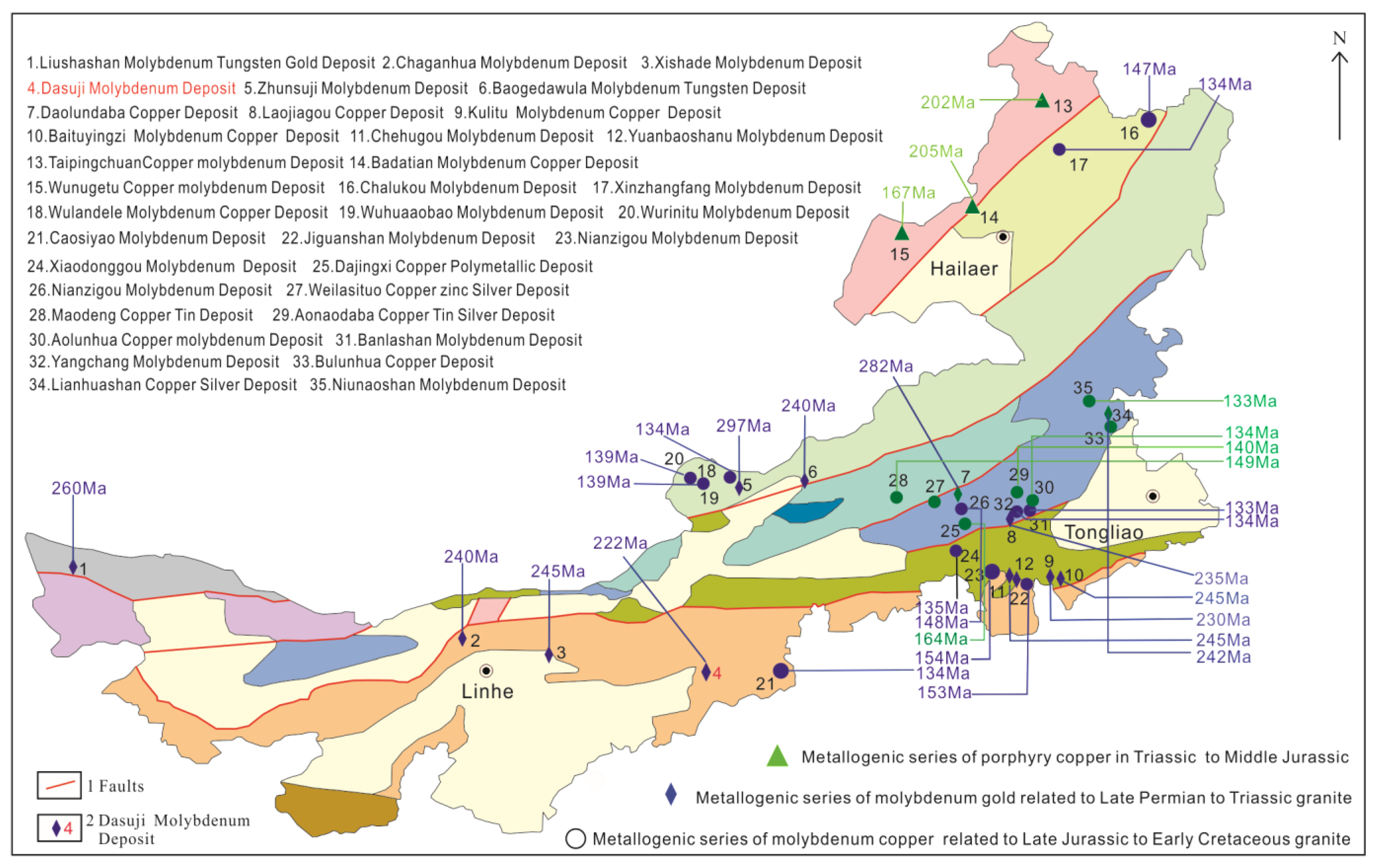

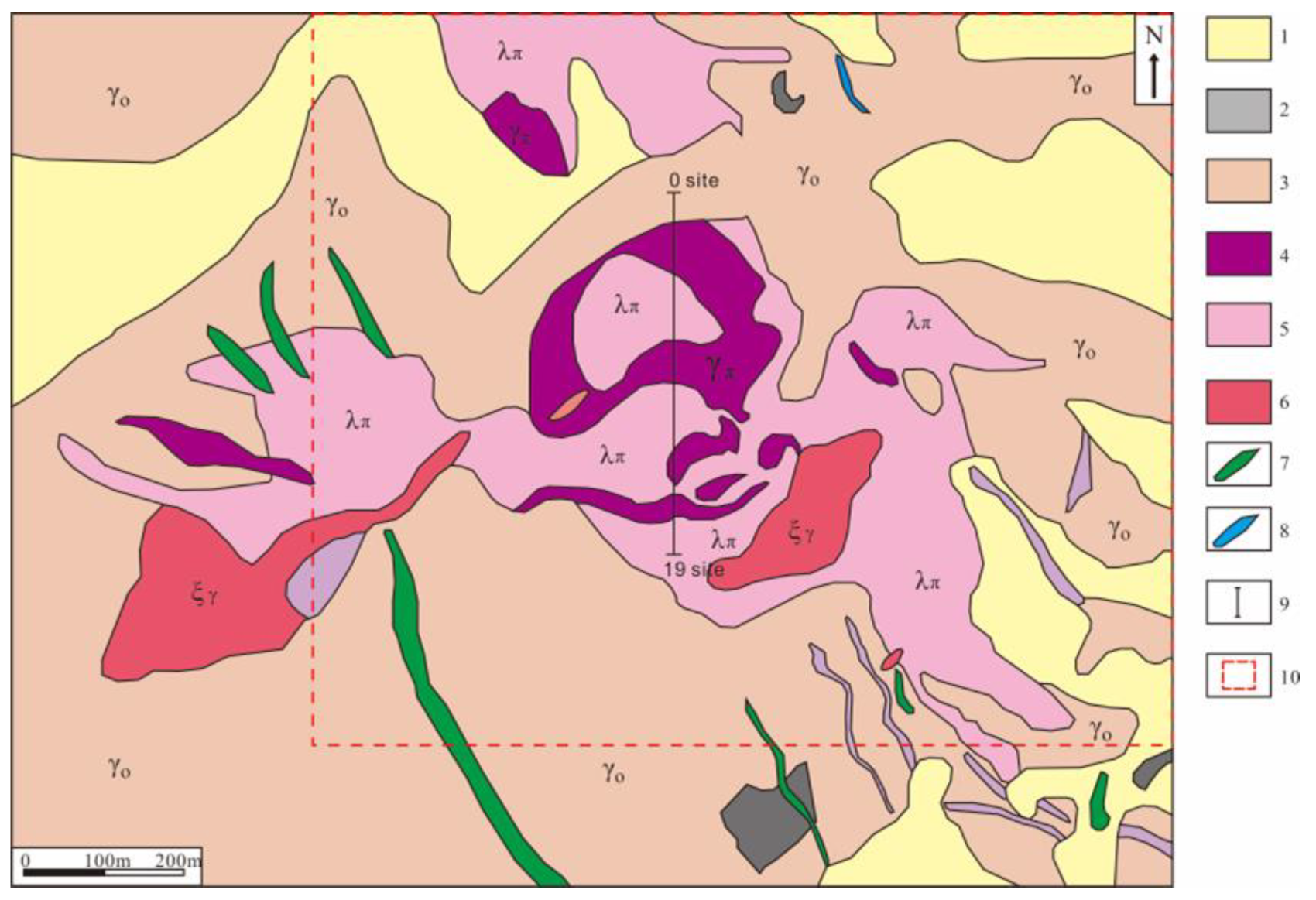


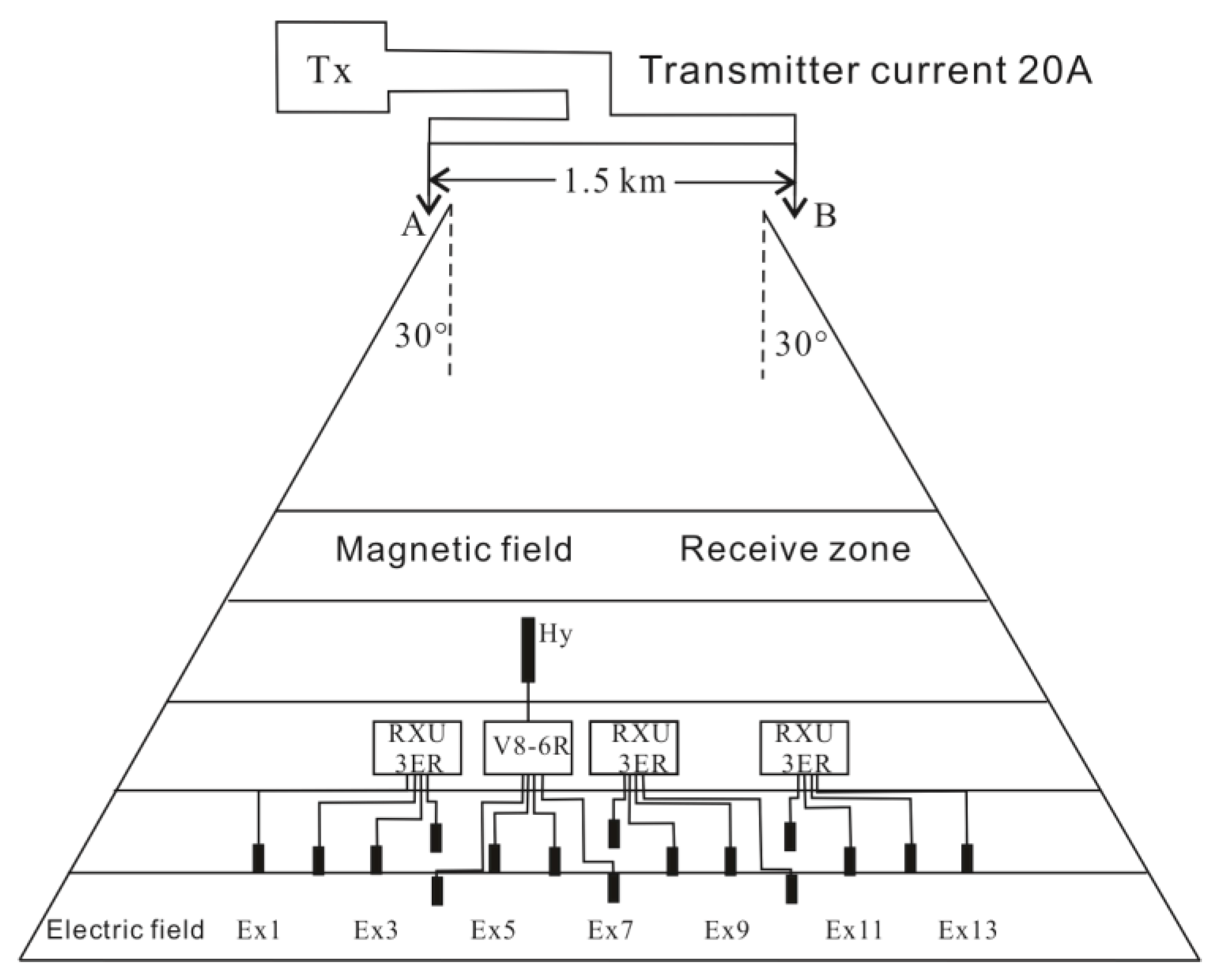
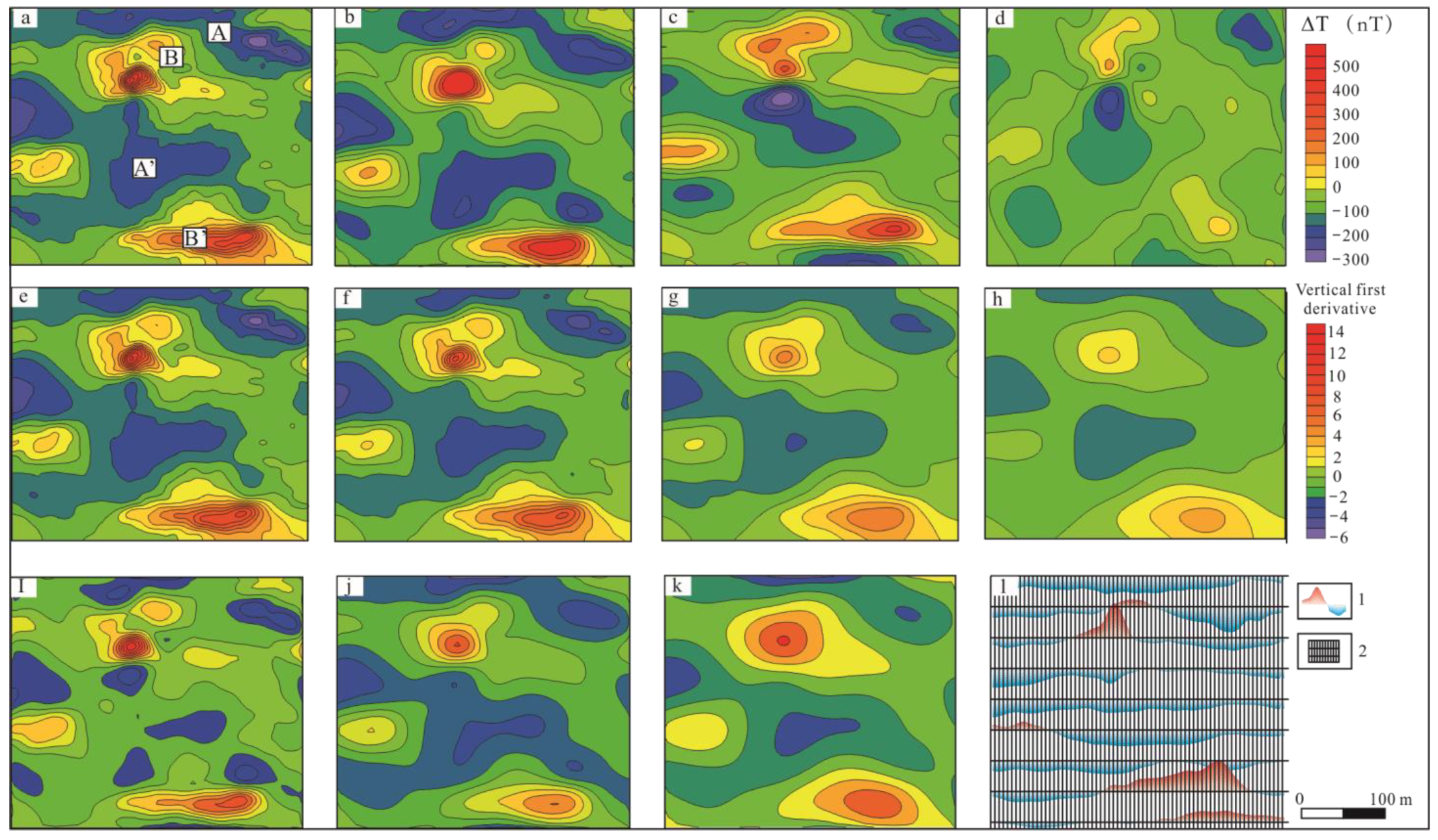

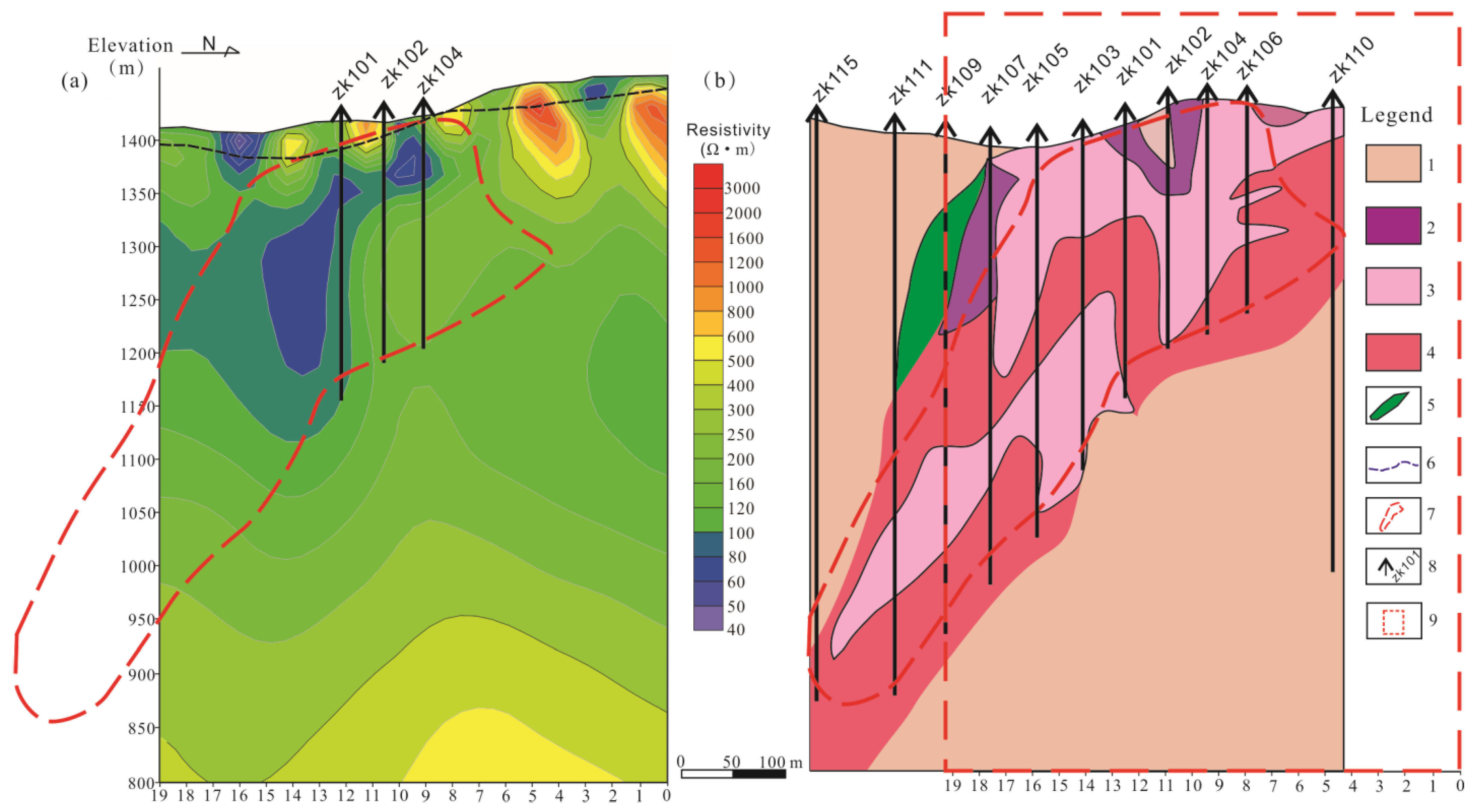
| Lithology | Drilling Depth | Length | Area | I | U | ρ | K |
|---|---|---|---|---|---|---|---|
| (m) | (mm) | (mm2) | (μA) | (mV) | (Ω·m) | (10−5 SI) | |
| Quartz porphyry | 4.50 | 12 | 23.74 | 20 | 12,517.57 | 1238.20 | 7.54 |
| Quartz porphyry | 5.00 | 18 | 23.74 | 16 | 12,567.67 | 1035.96 | 8.80 |
| Quartz porphyry | 7.65 | 13 | 23.74 | 17 | 12,552.34 | 1348.38 | 5.03 |
| Quartz porphyry | 7.85 | 15 | 23.74 | 13 | 12,615.83 | 1535.90 | 15.08 |
| Quartz porphyry | 8.45 | 16 | 23.74 | 18 | 12,538.54 | 1033.56 | 6.28 |
| Quartz porphyry | 8.65 | 15 | 23.74 | 9 | 12,675.16 | 2228.95 | 10.05 |
| Quartz porphyry | 9.05 | 15 | 23.74 | 12 | 12,621.08 | 1664.58 | 18.85 |
| Quartz porphyry | 10.45 | 9 | 23.74 | 19 | 12,521.62 | 1738.38 | 11.31 |
| Ore-bearing quartz porphyry | 12.55 | 16 | 23.74 | 24 | 12,481.51 | 771.64 | 2.51 |
| Ore-bearing granite porphyry | 39.70 | 14 | 23.74 | 38 | 12,362.76 | 551.68 | 32.67 |
| Alkaline granite | 43.55 | 17 | 23.74 | 7 | 12,776.35 | 2548.83 | 16.34 |
| Alkaline granite | 45.80 | 10 | 23.74 | 19 | 12,523.01 | 1564.72 | 40.21 |
| Alkaline granite | 121.35 | 10 | 23.74 | 14 | 12,586.20 | 2134.26 | 18.85 |
| Alkaline granite | 122.15 | 14 | 23.74 | 13 | 12,584.46 | 1641.51 | 21.36 |
| Alkaline granite | 122.30 | 11 | 23.74 | 16 | 12,599.47 | 1699.50 | 30.16 |
| Plagioclase granite | 230.30 | 18 | 23.74 | 26 | 12,445.88 | 631.34 | 541.59 |
| Plagioclase granite | 231.10 | 20 | 23.74 | 68 | 12,170.51 | 212.45 | 625.79 |
| Plagioclase granite | 231.35 | 20 | 23.74 | 19 | 12,520.37 | 782.19 | 412.16 |
| Method | Key Parameter | Company | Measurement Range | Measurement Points | Spatial Resolution |
|---|---|---|---|---|---|
| Aeromagnetism | Total magnetic field | Danian, China | 10 km2 | 222,811 | 0.1 m × 50 m |
| CSAMT | Apparent resistivity | Phoenix, Canada | 1000 m | 20 | 50 m |
| Ore Type | Elevation (m) | Resource Reserve Type (code) | Control Block Segment Volume (m3) | Density (t/m3) | Ore Content (kiloton) | Mo (ton) | Average Degree (%) |
|---|---|---|---|---|---|---|---|
| Oxidized ore | 1470–1346 | −331 | 1120,623 | 2.57 | 2880 | 2726 | 0.10 |
| −332 | 762,110 | 2.56 | 1951 | 1616 | 0.08 | ||
| −333 | 628,516 | 2.56 | 1609 | 1403 | 0.09 | ||
| All | 2511,249 | 6440 | 5745 | 0.09 | |||
| Sulfide ore | 1345–1056 | (122b) | 14,832,558 | 2.58 | 38,268 | 50,679 | 0.13 |
| −333 | 12,907,751 | 2.58 | 33,302 | 44,268 | 0.13 | ||
| All | 41,186,434 | 2.58 | 106,261 | 143,613 | 0.14 | ||
| Total | 1470–1056 | (122b) | 14,832,558 | 2.58 | 38,268 | 50,679 | 0.13 |
| −331 | 1120,623 | 2.57 | 2880 | 2726 | 0.10 | ||
| −332 | 762,109 | 2.56 | 1951 | 1616 | 0.08 | ||
| −333 | 1353,140 | 2.58 | 34,911 | 45,671 | 0.13 | ||
| Total | 43,682,558 | 2.58 | 112,701 | 149,358 | 0.13 |
| Block Number | Block Method | Horizontal Projection Method | Estimated Difference | |||
|---|---|---|---|---|---|---|
| Ore Content (Kt) | Mo (ton) | Ore Content (Kt) | Mo (ton) | Ore Content (Kt) | Mo (ton) | |
| 122b-7 | 967.20 | 1508.86 | 1022.30 | 1686.71 | −55.10 | −177.85 |
| 122b-8 | 1347.10 | 2357.55 | 1672.40 | 3093.92 | −325.30 | −736.37 |
| 121b-1 | 1694.00 | 2608.76 | 1628.90 | 2557.39 | 65.10 | 51.37 |
| 121b-2 | 2100.20 | 3045.32 | 1980.60 | 2911.48 | 119.60 | 133.84 |
| 121b-3 | 2328.90 | 3283.86 | 2295.30 | 3305.29 | 33.60 | −21.43 |
| 121b-4 | 2645.10 | 3491.65 | 2720.30 | 3617.96 | −75.20 | −126.31 |
| 121b-5 | 3348.80 | 3817.73 | 3325.50 | 3890.79 | 23.30 | −73.06 |
| 121b-6 | 1388.60 | 2180.17 | 1382.70 | 2212.32 | 5.90 | −32.15 |
| 121b-7 | 1446.20 | 2097.02 | 1495.70 | 2228.59 | −49.50 | −131.57 |
| 121b-8 | 1706.70 | 2508.88 | 1702.20 | 2570.35 | 4.50 | −61.47 |
| 121b-9 | 2029.30 | 2678.75 | 1889.00 | 2512.36 | 140.30 | 166.39 |
| 121b-10 | 1379.20 | 1668.84 | 1224.20 | 1469.00 | 155 | 199.84 |
| Total | 22,381.30 | 31,247.39 | 22,339.00 | 32,056.16 | 42.30 | −808.77 |
| Difference | 0.19% | −2.52% | ||||
Disclaimer/Publisher’s Note: The statements, opinions and data contained in all publications are solely those of the individual author(s) and contributor(s) and not of MDPI and/or the editor(s). MDPI and/or the editor(s) disclaim responsibility for any injury to people or property resulting from any ideas, methods, instructions or products referred to in the content. |
© 2025 by the authors. Licensee MDPI, Basel, Switzerland. This article is an open access article distributed under the terms and conditions of the Creative Commons Attribution (CC BY) license (https://creativecommons.org/licenses/by/4.0/).
Share and Cite
Xu, Z.; Niu, X.; Shi, B.; Yang, Z.; He, H.; Fan, W.; Gu, G.; Wang, Y.; Yang, N. Deep Exploration Porphyry Molybdenum Deposit in Dasuji, Inner Mongolia: Insight from Aeromagnetism and Controlled-Source Audio-Magnetotellurics. Minerals 2025, 15, 166. https://doi.org/10.3390/min15020166
Xu Z, Niu X, Shi B, Yang Z, He H, Fan W, Gu G, Wang Y, Yang N. Deep Exploration Porphyry Molybdenum Deposit in Dasuji, Inner Mongolia: Insight from Aeromagnetism and Controlled-Source Audio-Magnetotellurics. Minerals. 2025; 15(2):166. https://doi.org/10.3390/min15020166
Chicago/Turabian StyleXu, Zhihe, Xingguo Niu, Bin Shi, Zhongjie Yang, Haoyuan He, Weijing Fan, Guanwen Gu, Yingjie Wang, and Ningning Yang. 2025. "Deep Exploration Porphyry Molybdenum Deposit in Dasuji, Inner Mongolia: Insight from Aeromagnetism and Controlled-Source Audio-Magnetotellurics" Minerals 15, no. 2: 166. https://doi.org/10.3390/min15020166
APA StyleXu, Z., Niu, X., Shi, B., Yang, Z., He, H., Fan, W., Gu, G., Wang, Y., & Yang, N. (2025). Deep Exploration Porphyry Molybdenum Deposit in Dasuji, Inner Mongolia: Insight from Aeromagnetism and Controlled-Source Audio-Magnetotellurics. Minerals, 15(2), 166. https://doi.org/10.3390/min15020166






